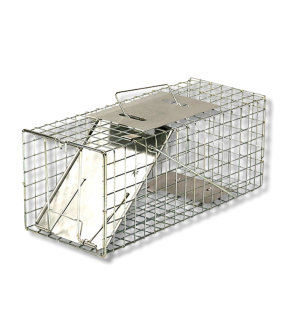Gain access to personalized product screening, the best pricing, rewards, and more!
Most Effective Products
How to Release an Animal from a Live Trap
 Live trapping is a safe and efficient way to control pests. If done correctly, you will see a pest animal caught in the trap. At this point, some people might not know how to safely relocate the animal. It might potentially be dangerous for the animal if it is relocated in an area it does not belong in, or if you release it at a time where it should be resting.
Live trapping is a safe and efficient way to control pests. If done correctly, you will see a pest animal caught in the trap. At this point, some people might not know how to safely relocate the animal. It might potentially be dangerous for the animal if it is relocated in an area it does not belong in, or if you release it at a time where it should be resting.
It is important to contact animal control before taking any other steps to understand the local laws about releasing an animal. This will ensure that you are not breaking any laws while safely returning an animal to the wild.
If you are unsure of how to release the animal in your live trap, follow this DIY guide for instructions for a safe and effective release.
Contact Animal Control
Before releasing the animal inside your live trap, find out if there are any laws or regulations about releasing a wild animal. Depending on where you live, you might have to travel a certain amount of miles before releasing the animal, or there may be restrictions on where you can let it go.
Generally, you might have to travel several miles before opening your trap. Raccoons, for example, can possibly find its way back to your area if you release it less than twenty miles away.
Approach with Caution
Before coming into contact with your live trap or handling it, be sure to wear the proper personal protective equipment (PPE), which are gloves and long clothing. This is to prevent any contact with the animal.
When approaching your live trap to release the animal, keep in mind that the animal will most likely be frightened. Walk slowly and use a soothing voice if needed. Use a towel or blanket to cover up the cage to avoid scaring the animal further.
You will need to pick up the live trap cage to relocate the animal. When doing so, hold it away from your body to avoid contact with the pest.
Safely Release the Animal
Check with your local animal control to get info on the appropriate area where you can release the animal from the live trap. If permitted, it is best to release the animal at least twenty miles away from your property. While some might suggest releasing the animal across a body of water, pest animals such as raccoons and opossums can be particularly good swimmers.
You will want to release the animal in a grassy area. When preparing to release the pest, be sure you are behind the cage to give the animal optimal room to leave the trap.
Remove the towel from the cage gently and slowly open the door to the trap. Generally the pest will quickly leave the cage but sometimes might take a little bit of time to escape.
After releasing the animal from the live trap, you will need to properly clean the trap. You can create a diluted solution with bleach and water to do so. Apply this to the cage and wait for it to dry.
Prevent Re-emergence
After you've released your captured animal from the live trap and into the wild, you can take some preventative measures to make sure animals avoid your property.
Sanitation
Sweep and remove any debris from your property. Materials such as landscaping items and firewood might be used as wild animals for nesting materials. Bind firewood tightly and keep it away from your home to prevent a wild animal from entering your home.







